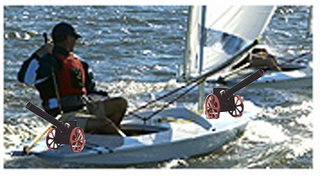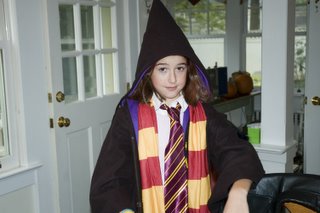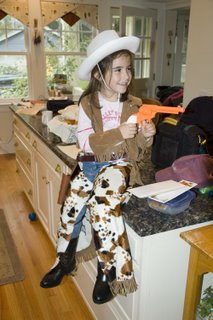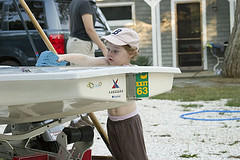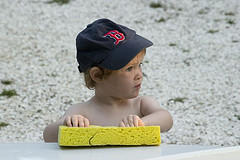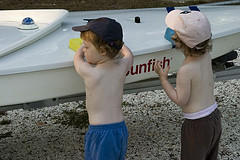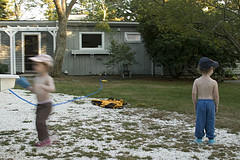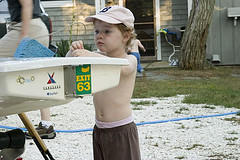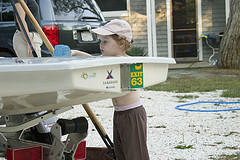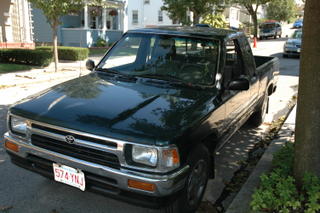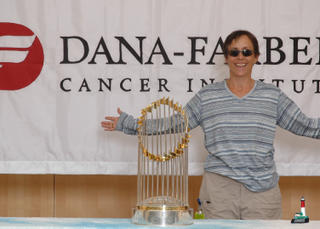Tuesday, November 29, 2005
The Time Has Come
Time to start planning the Yankee-Swap! Who's in? What's the suggested limit? Remember, unless you are under 16 or over 60, participation in the Virtual Yankee-Swap(tm) precludes you from receiving otherwise tangible gift like items from others in the VY-S. Not that you would be guaranteed of getting one anyway!
Thursday, November 24, 2005
Last Race Report of the Season
Part 1: No Sooner Said Than Done
My last race report ended, as you may recall, with the words “Providing, of course, that I don’t run into anything.” Life keeps teaching us an important lesson, and we (or, at least, I) keep failing to learn it — Do not tempt fate. The very next time I sailed, I ran into something.
The occasion was the Harbor Sailboats Fall Fleet Race, an annual event that sends racers in any type of boat off on a handicapped random-leg course. It was entirely separate from the Capri 22 series about which I’ve been reporting, but I was sailing a Capri 22 anyway, with Emma as crew. Ross and Kyle were competing in their own 22.
In the final (but long) leg of the race, I was sailing close-hauled on starboard tack. I came into range of a 30-or-so-foot boat called Tangaroa, sailing close-hauled on port tack. If you know your right-of-way rules, you know he was required to get out of my way. But he crossed ahead of me with too little room to pass clearly; I hailed him, and he did nothing; I attempted to evade him, but we hit.
Fortunately, no one was hurt, and damage was limited to my bow pulpit being bent out of shape. (Should you happen not to know, a bow pulpit is a structure of stainless steel pipes mounted on the bow to give crew something to grab onto. It’s absent from smaller boats, but standard on larger boats.)
Incredibly, even after the collision this guy seemed intent on getting in my way. We crossed three or four more times and, regardless of what the rules might require, I had to evade him every time.
The New York Times, by convention, declares itself a “family newspaper” and declines to use off-color language even when a story might make such language appropriate. Well this, I suppose, is a family blog. So allow me, by way of editorial comment, to note that Tangaroa is the name not only of the boat with which I collided, but also of a mythical Polynesian god renowned for an anatomical characteristic entirely in keeping with my opinion of the boat’s skipper.
Part 2: All’s Well That Ends Well
So — Race 4. I was there, with Emma once again as crew. Steve was there. Dennis was there. So were two other boats. But the wind was somewhere else.
Because there was literally no breeze, we had to motor out to reach the course before the race began. Just before the start (and I mean perhaps two minutes before the start) a waft of breeze materialized on the right side of the start line. I got the best of it — regardless of how I can finish, these days apparently I sure can start. The breeze continued to build, and at the first mark I was in first place.
But Steve passed me on the second leg, a close reach, and Dennis came up close behind. As we rounded the second mark, Steve set a course to, and then along, North Island. We were in a strong ebb tide, and Steve was trying to avoid it as best he could. But Dennis went out into the middle of the bay. I followed Steve but, tide or no tide, Dennis kicked our butts. Within a space of perhaps ten minutes, he was at least 30 boat lengths ahead.
So I altered course to go out into the bay, where the tide may have been stronger, but so was the wind. I began to catch Dennis; I began to leave Steve behind; but the wind began to drop. By the time it dropped to nothing (my GPS read 0.0 knots of boat speed), I was ahead of Dennis, well ahead of Steve, and the others weren’t even a consideration.
But now the true breeze filled in — from behind. This meant that every boat gained ground while I drifted, waiting for wind. (By the way, “gained ground” is the term I hear used, but why? Shouldn’t it be “gained water”?) I imagine there is no more frustrating sensation on this planet.
Here’s where Steve’s stay-out-of-the-current strategy paid off. Once the wind reached all of us and we were all moving well, he moved a little better. And a little at any moment adds up to a lot after many moments; by the time he reached the downwind mark he was very safely in first. I reached it in second, Dennis in third, and the others once more not even a consideration.
Now it was close-hauled sailing to the finish. I suffered a “moment” — actually about three minutes — during which I couldn’t point or move the boat at all well, and Dennis caught and passed me. But then, as we continued to sail, I gained ground (there’s that word again). It all came down to a single crossing — I on starboard, Dennis on port — on which our boats were inches apart. A puff hit us and my boat rounded up naturally onto a course that would have led me to hit him. And I had right of way….
But I already owed Harbor Sailboats for a new bow pulpit. What’s more, I suddenly recalled: This race didn’t matter. He had to put five boats between me and him in order to pass me in the overall standings. So, I turned down, passed behind him, and ended up taking third in the race, but second overall in the regatta. First went to Steve, and Steve: Congratulations!
My last race report ended, as you may recall, with the words “Providing, of course, that I don’t run into anything.” Life keeps teaching us an important lesson, and we (or, at least, I) keep failing to learn it — Do not tempt fate. The very next time I sailed, I ran into something.
The occasion was the Harbor Sailboats Fall Fleet Race, an annual event that sends racers in any type of boat off on a handicapped random-leg course. It was entirely separate from the Capri 22 series about which I’ve been reporting, but I was sailing a Capri 22 anyway, with Emma as crew. Ross and Kyle were competing in their own 22.
In the final (but long) leg of the race, I was sailing close-hauled on starboard tack. I came into range of a 30-or-so-foot boat called Tangaroa, sailing close-hauled on port tack. If you know your right-of-way rules, you know he was required to get out of my way. But he crossed ahead of me with too little room to pass clearly; I hailed him, and he did nothing; I attempted to evade him, but we hit.
Fortunately, no one was hurt, and damage was limited to my bow pulpit being bent out of shape. (Should you happen not to know, a bow pulpit is a structure of stainless steel pipes mounted on the bow to give crew something to grab onto. It’s absent from smaller boats, but standard on larger boats.)
Incredibly, even after the collision this guy seemed intent on getting in my way. We crossed three or four more times and, regardless of what the rules might require, I had to evade him every time.
The New York Times, by convention, declares itself a “family newspaper” and declines to use off-color language even when a story might make such language appropriate. Well this, I suppose, is a family blog. So allow me, by way of editorial comment, to note that Tangaroa is the name not only of the boat with which I collided, but also of a mythical Polynesian god renowned for an anatomical characteristic entirely in keeping with my opinion of the boat’s skipper.
Part 2: All’s Well That Ends Well
So — Race 4. I was there, with Emma once again as crew. Steve was there. Dennis was there. So were two other boats. But the wind was somewhere else.
Because there was literally no breeze, we had to motor out to reach the course before the race began. Just before the start (and I mean perhaps two minutes before the start) a waft of breeze materialized on the right side of the start line. I got the best of it — regardless of how I can finish, these days apparently I sure can start. The breeze continued to build, and at the first mark I was in first place.
But Steve passed me on the second leg, a close reach, and Dennis came up close behind. As we rounded the second mark, Steve set a course to, and then along, North Island. We were in a strong ebb tide, and Steve was trying to avoid it as best he could. But Dennis went out into the middle of the bay. I followed Steve but, tide or no tide, Dennis kicked our butts. Within a space of perhaps ten minutes, he was at least 30 boat lengths ahead.
So I altered course to go out into the bay, where the tide may have been stronger, but so was the wind. I began to catch Dennis; I began to leave Steve behind; but the wind began to drop. By the time it dropped to nothing (my GPS read 0.0 knots of boat speed), I was ahead of Dennis, well ahead of Steve, and the others weren’t even a consideration.
But now the true breeze filled in — from behind. This meant that every boat gained ground while I drifted, waiting for wind. (By the way, “gained ground” is the term I hear used, but why? Shouldn’t it be “gained water”?) I imagine there is no more frustrating sensation on this planet.
Here’s where Steve’s stay-out-of-the-current strategy paid off. Once the wind reached all of us and we were all moving well, he moved a little better. And a little at any moment adds up to a lot after many moments; by the time he reached the downwind mark he was very safely in first. I reached it in second, Dennis in third, and the others once more not even a consideration.
Now it was close-hauled sailing to the finish. I suffered a “moment” — actually about three minutes — during which I couldn’t point or move the boat at all well, and Dennis caught and passed me. But then, as we continued to sail, I gained ground (there’s that word again). It all came down to a single crossing — I on starboard, Dennis on port — on which our boats were inches apart. A puff hit us and my boat rounded up naturally onto a course that would have led me to hit him. And I had right of way….
But I already owed Harbor Sailboats for a new bow pulpit. What’s more, I suddenly recalled: This race didn’t matter. He had to put five boats between me and him in order to pass me in the overall standings. So, I turned down, passed behind him, and ended up taking third in the race, but second overall in the regatta. First went to Steve, and Steve: Congratulations!
Saturday, November 19, 2005
Friday, November 11, 2005
Race Three
Sure there was a race last Saturday, and there are results to report, but let’s skip straight to the good stuff: the most spectacular collision I’ve ever seen.
Bear in mind, I’ve seen more than a couple in the last couple of years (and, in fact, been involved in a few of them). Even Tom Hirsh, the guy who owns the boats we race and who has publicly proclaimed something close to a you-bang-em-you-buy-em policy, mentioned privately just last week that “if you don’t crash now and again you’re just not trying hard enough.” But this was a doozy.
A cutter called the Californian, the official “tall ship” of the state of California and a beast of some 130 tons, often cruises San Diego Bay. This particular day, it was out and about along with another sailing ship — name and exact size, I regret to say, unknown, but it was nearly as large, and let’s call it the Phantom. The two were scheduled to go out and blast cannons (plenty of gunpowder, no actual balls) at each other the next day, and they were, I suppose, warming up.
And there we were — “we” being myself and Midshipman Krabby Kyle — close-hauled on the final leg of our race, battling it out with archrival Steve McNally for first. We were on port tack, and I could see that the Phantom was on collision course on starboard. He had, in other words, right of way. But you know what? That didn’t matter. The law of gross tonnage applied here, and I was going to get out of his way. We tacked, and it cost us, and we were annoyed that we had to tack, but all was well.
Now, the Chapman brothers were in our race. As it happens, I am the only person to have entered a boat in these races longer and more regularly than they have. They’re established. But they have a record — a “crash-to-takeoff ratio,” as Tom put it in that private conversation, far exceeding that of any other entrant. They’re also remarkably uneven sailors; sometimes they’re way back in the fleet, and sometimes they contend for first. This was one of the latter occasions. They’d led much of the race and, only in a late leg, had fallen into a close third.
So, a minute or two after we were clear of the Phantom, I heard a noise. I looked back. There were the Chapmans, in exactly the same situation in which I had found myself a few minutes before, except apparently they’d never heard of the law of gross tonnage. (Admittedly, it’s a concept that’s essentially intuitive; I doubt it appears in any rule book.) They were crossing before the Phantom, on port to its starboard (as if that mattered!), and they had already made contact — hence the noise. The Chapman’s mast and the ship’s bowsprit had fouled, and I watched their mast being literally ripped right off their boat.
Hoochie Mamma! But, amazingly, there was no hull-to-hull contact, and no one was hurt. Even so, I turned back to offer any help we could (a decision that seemed obvious to me). It took less than a minute to reach them and to have them convince us they were ok and wave us back into the race, but by then we had no chance of catching Steve. (And in fairness to Steve, we likely would not have caught him anyway.) But the turning back led us to be caught by another boat, and we ended up in third.
So, in the final race a week from this Saturday, it seems highly unlikely that I’ll catch Steve (I’d need to beat him by four boats), and even less likely that the third-place boat will catch me. So it looks like it will be a nice, leisurely affair resulting in a second overall. Providing, of course, that I don’t run into anything……
Bear in mind, I’ve seen more than a couple in the last couple of years (and, in fact, been involved in a few of them). Even Tom Hirsh, the guy who owns the boats we race and who has publicly proclaimed something close to a you-bang-em-you-buy-em policy, mentioned privately just last week that “if you don’t crash now and again you’re just not trying hard enough.” But this was a doozy.
A cutter called the Californian, the official “tall ship” of the state of California and a beast of some 130 tons, often cruises San Diego Bay. This particular day, it was out and about along with another sailing ship — name and exact size, I regret to say, unknown, but it was nearly as large, and let’s call it the Phantom. The two were scheduled to go out and blast cannons (plenty of gunpowder, no actual balls) at each other the next day, and they were, I suppose, warming up.
And there we were — “we” being myself and Midshipman Krabby Kyle — close-hauled on the final leg of our race, battling it out with archrival Steve McNally for first. We were on port tack, and I could see that the Phantom was on collision course on starboard. He had, in other words, right of way. But you know what? That didn’t matter. The law of gross tonnage applied here, and I was going to get out of his way. We tacked, and it cost us, and we were annoyed that we had to tack, but all was well.
Now, the Chapman brothers were in our race. As it happens, I am the only person to have entered a boat in these races longer and more regularly than they have. They’re established. But they have a record — a “crash-to-takeoff ratio,” as Tom put it in that private conversation, far exceeding that of any other entrant. They’re also remarkably uneven sailors; sometimes they’re way back in the fleet, and sometimes they contend for first. This was one of the latter occasions. They’d led much of the race and, only in a late leg, had fallen into a close third.
So, a minute or two after we were clear of the Phantom, I heard a noise. I looked back. There were the Chapmans, in exactly the same situation in which I had found myself a few minutes before, except apparently they’d never heard of the law of gross tonnage. (Admittedly, it’s a concept that’s essentially intuitive; I doubt it appears in any rule book.) They were crossing before the Phantom, on port to its starboard (as if that mattered!), and they had already made contact — hence the noise. The Chapman’s mast and the ship’s bowsprit had fouled, and I watched their mast being literally ripped right off their boat.
Hoochie Mamma! But, amazingly, there was no hull-to-hull contact, and no one was hurt. Even so, I turned back to offer any help we could (a decision that seemed obvious to me). It took less than a minute to reach them and to have them convince us they were ok and wave us back into the race, but by then we had no chance of catching Steve. (And in fairness to Steve, we likely would not have caught him anyway.) But the turning back led us to be caught by another boat, and we ended up in third.
So, in the final race a week from this Saturday, it seems highly unlikely that I’ll catch Steve (I’d need to beat him by four boats), and even less likely that the third-place boat will catch me. So it looks like it will be a nice, leisurely affair resulting in a second overall. Providing, of course, that I don’t run into anything……
Wednesday, November 02, 2005
Monday, October 31, 2005
Coincidence? I Think Not!
It all began with AWA713. Then (years later, I admit), I bought my first Accord and received at random a license plate on which the letter characters were MLC. Then Ross got his VKK license plate. Now the state of California has finally sent me the plates for my new car: 5RLS868. I want to know how come they left out the D?
Thursday, October 27, 2005
Mark Your Calendars

Only 47 days 10 hours 56 minutes until the December 14th release of the 3 hour long King Kong remake!
Wednesday, October 26, 2005
Race Two
What could be more different? Gray, overcast, drizzly skies where the previous race day was sunny; light (almost no) wind when before there was plenty; and in place of the experienced Kyle, a jib trimmer who, it turned out, would be stepping into a sailboat for the very first time. Still, my lucky hat remained the same; let’s see what it could do for me.
First, the new crew (to introduce him) was Tyler Olmstead, a fellow Aikido student. After working out with him for several years, I knew that he possesses considerable stores of balance, timing, and natural physical ability, so despite his inexperience, I was confident. And by the end of the day, I was not at all disappointed.
We sailed another random-leg course, but because the wind was light, this course was considerably shorter than the first one (a fact that will resonate later in the story). The course meandered here and there through San Diego Bay, and, in an unusual touch, ended right off the Harbor Sailboats dock. This meant leaving the wide bay and traversing relatively narrow passages around the western tip of Harbor Island and then down its northern side.
Unlike the first race, this one decidedly favored a starboard-tack start, and we got the best of it. Midway up the first leg, though, we had a little “crew training” moment, which was enough to allow one boat, skippered by a guy named Dennis Burks, to reach the first mark just before us. That first mark was red 20, quite close to what is at that point the southern bank of the bay (called North Island; go figure). As so often happens, Dennis and I focused on one another, reaching out toward the middle of the bay, and let a third boat sail off on another heading, along North Island, to pass us. That would be our old pal Steve McNally. But before he could go too far on his own, I broke off to cover him while Dennis continued on to the left. The result was that Steve was first to the second mark, I was a close second, and others were farther behind.
Rounding that second mark (red 22, once again in case you have a chart), I managed to turn inside of Steve, and we were neck and neck. From here it was a long dash to the finish, close-hauled most of the way. (There was another mark along the way, but the course to the finish made it almost impossible to miss, so we pretty much ignored it.) At times, I was ahead of Steve; at times, he was ahead of me; and as we focused on one another (do I never learn?), Dennis came up into contention. As we approached that narrow passage around Harbor Island, they were both a bit ahead of me, but I was farther upwind and so narrowly in first.
When, doh! I tacked toward the passage around the tip of Harbor Island and discovered that I had miscalled the lay line. Needing therefore to make two extra tacks, I watched both Steve and then Dennis go by me.
But it wasn’t over yet. Close reaching around the western tip of the island, Steve and Dennis took each other a little wide, and I gained. Then broad reaching down the northern side of the island, I seemed to get my sails set a little better than the others. I didn’t have a chance to catch Steve (who ended up finishing first), but as I approached the finish line, I heard a voice from Dennis’s boat — “Oh no!” — as I came along side him with much better speed. And it ended .... with Dennis about a foot ahead of me. If the race course had been ten yards longer, I would have taken second. But I got an exciting third instead.
And so, with two races down and two to go, it’s McNally with three points, Christie with four, and the next nearest competitor with eight.
First, the new crew (to introduce him) was Tyler Olmstead, a fellow Aikido student. After working out with him for several years, I knew that he possesses considerable stores of balance, timing, and natural physical ability, so despite his inexperience, I was confident. And by the end of the day, I was not at all disappointed.
We sailed another random-leg course, but because the wind was light, this course was considerably shorter than the first one (a fact that will resonate later in the story). The course meandered here and there through San Diego Bay, and, in an unusual touch, ended right off the Harbor Sailboats dock. This meant leaving the wide bay and traversing relatively narrow passages around the western tip of Harbor Island and then down its northern side.
Unlike the first race, this one decidedly favored a starboard-tack start, and we got the best of it. Midway up the first leg, though, we had a little “crew training” moment, which was enough to allow one boat, skippered by a guy named Dennis Burks, to reach the first mark just before us. That first mark was red 20, quite close to what is at that point the southern bank of the bay (called North Island; go figure). As so often happens, Dennis and I focused on one another, reaching out toward the middle of the bay, and let a third boat sail off on another heading, along North Island, to pass us. That would be our old pal Steve McNally. But before he could go too far on his own, I broke off to cover him while Dennis continued on to the left. The result was that Steve was first to the second mark, I was a close second, and others were farther behind.
Rounding that second mark (red 22, once again in case you have a chart), I managed to turn inside of Steve, and we were neck and neck. From here it was a long dash to the finish, close-hauled most of the way. (There was another mark along the way, but the course to the finish made it almost impossible to miss, so we pretty much ignored it.) At times, I was ahead of Steve; at times, he was ahead of me; and as we focused on one another (do I never learn?), Dennis came up into contention. As we approached that narrow passage around Harbor Island, they were both a bit ahead of me, but I was farther upwind and so narrowly in first.
When, doh! I tacked toward the passage around the tip of Harbor Island and discovered that I had miscalled the lay line. Needing therefore to make two extra tacks, I watched both Steve and then Dennis go by me.
But it wasn’t over yet. Close reaching around the western tip of the island, Steve and Dennis took each other a little wide, and I gained. Then broad reaching down the northern side of the island, I seemed to get my sails set a little better than the others. I didn’t have a chance to catch Steve (who ended up finishing first), but as I approached the finish line, I heard a voice from Dennis’s boat — “Oh no!” — as I came along side him with much better speed. And it ended .... with Dennis about a foot ahead of me. If the race course had been ten yards longer, I would have taken second. But I got an exciting third instead.
And so, with two races down and two to go, it’s McNally with three points, Christie with four, and the next nearest competitor with eight.
Sunday, October 23, 2005
As long as we're on the topic of etymology
As long as we're on the topic of etymology:
"'Every man meets his Waterloo at last,' wrote the nineteenth-century American moralist Wendell Phillips, and the phrase has indeed slipped into the English language to imply that there is a fate, an inescapable destiny, awaiting us all." Andrew Roberts, Waterloo: The Battle for Modern Europe (HarperCollins, 2005).
So - the next time you're playing Hearts, think of the three-threes as a matter of morality.
"'Every man meets his Waterloo at last,' wrote the nineteenth-century American moralist Wendell Phillips, and the phrase has indeed slipped into the English language to imply that there is a fate, an inescapable destiny, awaiting us all." Andrew Roberts, Waterloo: The Battle for Modern Europe (HarperCollins, 2005).
So - the next time you're playing Hearts, think of the three-threes as a matter of morality.
Wednesday, October 19, 2005
Eat it & have it or Have it & eat it ?
I was net surfing and came across this:
[Q] From Colin Rogers and Alison Braid-Skolski: “We are perplexed by the confusing phrase have your cake and eat it. I have always thought this a common misconception and it should be eat your cake and have it?”
[A] Whoever expected English idioms to be logical? The usual way in which one sees this one is as the negative you can’t have your cake and eat it, expressing the idea that you have to make an either/or choice, that you can’t reconcile two mutually incompatible situations. It would be a little clearer if it were written as you can’t both have your cake and eat it. It would be more obviously the same as the other form if you also rewrote that as you can’t eat your cake and still have it.
Quite why the saying has settled on this form isn’t clear. I learned it as a youth as you can’t eat your cake and have it, too, and there are more examples in my databases that way than in the can’t have your cake and eat it inversion. Those who first used it certainly agreed with your sense of logic. Though presumably rather older, it is first written down in John Heywood’s A Dialogue Conteynyng Prouerbes and Epigrammes of 1562: “Wolde ye bothe eate your cake, and haue your cake?”. John Keats quoted it as eat your cake and have it at the beginning of his poem On Fame in 1816; Franklin D Roosevelt borrowed it in that form for his State of the Union Address in 1940; a search of nineteenth-century literature shows it to be about twice as common as the other. But a quick Google search shows the have your cake and eat it form is now about ten times as frequent, and all my dictionaries of idioms and proverbs cite it that way.
One of life’s little mysteries, I suppose. But whichever way you say it, you can be sure that it will be understood. So there’s no need to worry much over the logic!
[Q] From Colin Rogers and Alison Braid-Skolski: “We are perplexed by the confusing phrase have your cake and eat it. I have always thought this a common misconception and it should be eat your cake and have it?”
[A] Whoever expected English idioms to be logical? The usual way in which one sees this one is as the negative you can’t have your cake and eat it, expressing the idea that you have to make an either/or choice, that you can’t reconcile two mutually incompatible situations. It would be a little clearer if it were written as you can’t both have your cake and eat it. It would be more obviously the same as the other form if you also rewrote that as you can’t eat your cake and still have it.
Quite why the saying has settled on this form isn’t clear. I learned it as a youth as you can’t eat your cake and have it, too, and there are more examples in my databases that way than in the can’t have your cake and eat it inversion. Those who first used it certainly agreed with your sense of logic. Though presumably rather older, it is first written down in John Heywood’s A Dialogue Conteynyng Prouerbes and Epigrammes of 1562: “Wolde ye bothe eate your cake, and haue your cake?”. John Keats quoted it as eat your cake and have it at the beginning of his poem On Fame in 1816; Franklin D Roosevelt borrowed it in that form for his State of the Union Address in 1940; a search of nineteenth-century literature shows it to be about twice as common as the other. But a quick Google search shows the have your cake and eat it form is now about ten times as frequent, and all my dictionaries of idioms and proverbs cite it that way.
One of life’s little mysteries, I suppose. But whichever way you say it, you can be sure that it will be understood. So there’s no need to worry much over the logic!
Tuesday, October 11, 2005
It’s All in the Hat
You know the story. I bought a Harvey Cedars Marina hat, I wore it while taking two firsts on the first day of the Barnegat Light Regatta, I cavalierly gave the hat to Linda and bought a new one, only to have Linda clobber me in every race on the second day of the regatta. Obvious conclusion: I’d given away my luck along with the hat. The new chapeau was a dog.
Well not so fast...
I’ve been crewing quite a bit on Valhalla all the remainder of the summer, but I haven’t had a chance to skipper my own boat until last Saturday; working up in Irvine has prevented me from taking part in the Tuesday evening Capri 22 races. At long last, however, the racing shifted from Tuesdays to Saturdays, and there I was, with Midshipman Krabby Kyle as my able crew (he having found that his usual skipper has his own work-schedule conflicts). And I was wearing my second Harvey Cedars Marina hat. Yeah, my dog was barkin’.
There was a fairly strong breeze more or less out of the south — didn’t have an anemometer handy, but it was enough to raise whitecaps on a deepwater bay and make it something of a challenge to handle a small boat with enough sail area to be easily overpowered.
And on that breezy day we had a “random leg” race, stretching somewhere between 10 to 15 nautical miles around channel buoys in San Diego bay. (From off the eastern half of Harbor Island across the bay to red 20; on to green 15, about halfway between the southern end of Shelter Island and the end of Point Loma; back again to FM 19, off the eastern tip of Harbor Island; down to red 26 on the other side of the San Diego–Coronado Bridge; back to FM19; and then finishing where we started. Just in case you happen to have a chart.)
The start unequivocally favored a port tack, but of the eight boats sailing, only three of us seemed to notice. Of the three, I got the best start (I’m delighted to say), with Jon Miyate above but behind me on the unfavored end of a lee-bow placement, and Steve McNalley alongside but below me. The other five effectively put themselves out of the race at the start. (Although Traci Miller, a Valhalla shipmate skippering one of the starboard-tack starters, did manage to finish in third when all was said and done.) There were a couple of tacks along the way, but at red 20 Kyle and I were in first place.
Then it got interesting. The route from red 20 to green 15 was, for more than a mile, close-hauled on port tack; then (owing to the shape of the bay; our course had been westerly but veered into the south and into the wind) a quick starboard tack and another quick port tack. Along that long port tack, Jon neither gained nor fell behind, but Steve steadily gained, and gained, and gained, and finally got about a boat length ahead and upwind of me. But he took his starboard tack the moment he could, and I split tacks with him, staying on port perhaps five to ten minutes longer. By the time I went over to starboard and he came back onto port, I crossed ten boat lengths ahead of him. We talked later, and neither of us knew why. Maybe I hit a favorable current. Maybe it was my hat.
But anyway, the suspense ends there. Once I rounded the second mark (ahead), almost all the rest of the way was off the wind — beam to broad reach. Perhaps because I pay better attention to the trim of my sails (ask Kyle how often I made him make adjustments; I’d say about every 10 seconds), or have more experience sailing off the wind, or both, I just pulled away from everyone. Really, for your entertainment if for no other reason I wish I could make this more exciting, but I led by a lot at every mark — 10 to 20 lengths ahead of Steve and more than are worth counting ahead of everyone else.
(Yikes! Am I tempting fate! Allow me to remind you that I am an undistinguished technical writer and my Aikido is laughable.)
So, there’s nothing wrong with my hat after all. Of course, that means I can no longer blame it for my loss in the Barnegat Light Regatta. So let me say this: All you Harbor Sailboats racers, if you thought I was tough, just be glad you didn’t have to sail against my sister!
Well not so fast...
I’ve been crewing quite a bit on Valhalla all the remainder of the summer, but I haven’t had a chance to skipper my own boat until last Saturday; working up in Irvine has prevented me from taking part in the Tuesday evening Capri 22 races. At long last, however, the racing shifted from Tuesdays to Saturdays, and there I was, with Midshipman Krabby Kyle as my able crew (he having found that his usual skipper has his own work-schedule conflicts). And I was wearing my second Harvey Cedars Marina hat. Yeah, my dog was barkin’.
There was a fairly strong breeze more or less out of the south — didn’t have an anemometer handy, but it was enough to raise whitecaps on a deepwater bay and make it something of a challenge to handle a small boat with enough sail area to be easily overpowered.
And on that breezy day we had a “random leg” race, stretching somewhere between 10 to 15 nautical miles around channel buoys in San Diego bay. (From off the eastern half of Harbor Island across the bay to red 20; on to green 15, about halfway between the southern end of Shelter Island and the end of Point Loma; back again to FM 19, off the eastern tip of Harbor Island; down to red 26 on the other side of the San Diego–Coronado Bridge; back to FM19; and then finishing where we started. Just in case you happen to have a chart.)
The start unequivocally favored a port tack, but of the eight boats sailing, only three of us seemed to notice. Of the three, I got the best start (I’m delighted to say), with Jon Miyate above but behind me on the unfavored end of a lee-bow placement, and Steve McNalley alongside but below me. The other five effectively put themselves out of the race at the start. (Although Traci Miller, a Valhalla shipmate skippering one of the starboard-tack starters, did manage to finish in third when all was said and done.) There were a couple of tacks along the way, but at red 20 Kyle and I were in first place.
Then it got interesting. The route from red 20 to green 15 was, for more than a mile, close-hauled on port tack; then (owing to the shape of the bay; our course had been westerly but veered into the south and into the wind) a quick starboard tack and another quick port tack. Along that long port tack, Jon neither gained nor fell behind, but Steve steadily gained, and gained, and gained, and finally got about a boat length ahead and upwind of me. But he took his starboard tack the moment he could, and I split tacks with him, staying on port perhaps five to ten minutes longer. By the time I went over to starboard and he came back onto port, I crossed ten boat lengths ahead of him. We talked later, and neither of us knew why. Maybe I hit a favorable current. Maybe it was my hat.
But anyway, the suspense ends there. Once I rounded the second mark (ahead), almost all the rest of the way was off the wind — beam to broad reach. Perhaps because I pay better attention to the trim of my sails (ask Kyle how often I made him make adjustments; I’d say about every 10 seconds), or have more experience sailing off the wind, or both, I just pulled away from everyone. Really, for your entertainment if for no other reason I wish I could make this more exciting, but I led by a lot at every mark — 10 to 20 lengths ahead of Steve and more than are worth counting ahead of everyone else.
(Yikes! Am I tempting fate! Allow me to remind you that I am an undistinguished technical writer and my Aikido is laughable.)
So, there’s nothing wrong with my hat after all. Of course, that means I can no longer blame it for my loss in the Barnegat Light Regatta. So let me say this: All you Harbor Sailboats racers, if you thought I was tough, just be glad you didn’t have to sail against my sister!
Thursday, September 29, 2005
Port !
Imagine a very fast boat (Stars & Stripes) at least twice as large as this one that is coming at you on port tack while you are in a considerably smaller sailboat on a starboard tack. You have the right of way but does the other boat really see you? And it keeps getting closer and closer......
On Sunday, Dave took us (Emma, her friend Sarah, Kyle & I) out on Blue Canoe, a 32 foot Ericson. I was a beautiful day for sailing and we went out a few miles into the Pacific and seemed to own the ocean. Unfortunately, Sarah began feeling the effects of the ocean swells and so we returned to San Diego Bay for a more comfortable afternoon of sailing. Still, a beautiful day, a nice boat, plenty to eat and drink, who could ask for anything more? As we sailed around the bay we were accompanied by two America's Cup Yachts, Stars & Stripes and Abracadabra that take interested passengers for a thrilling ride up and down the bay. Even though we would be moving along at times at a pretty good clip, 6 1/2 to 7 knots, these big boys would go right past us as if we were anchored. Well, early in the afternoon we were on a starboard tack and heading toward the Coronado Bridge when Stars & Stripes began a port tack run in our direction. It is amazing how quickly that boat can move over water! And it is amazing how nervous you can be as it gets closer and closer and you start to wonder if they see you and are they going to go in front or behind or straight into you? Should we hold our course or go into evasive maneuvers? Or just jump ship and swim for it? I guess that they were just kind of playing chicken with us but we didn't chicken out! They ended up going behind us like a rocket.
Skipper Dave with nerves of steel, true and brave, steady on the wheel, the good sailing vessel Blue Canoe, starboard! or not, an able bodied crew, is that a yacht or a Guernsey Cow?, we crossed Stars & Stripes bow!!!
Monday, September 26, 2005
Fair Warnings
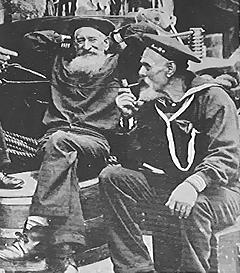
Saturday was a beautiful, warm early autumn day on old Cape Cod, with blue skies and a good strong wind as we waited around to start power washing my friend's house in Truro, where Cher just happened to be sitting in the garage, and a boat launching ramp into Cape Cod Bay just happened to be down the road about a 1/4 mile (if that). Erica stayed home with the napping twins, Rosemary and Gretchen went off in search of lunch, and I of course headed down to the water with my $10 in hand to pay the harbormaster. "What's that you got there? A kayak?" I paused, wondering how I should answer, as a kayak only costs $5 to launch.
I figured no sense irritating the old guy who would undoubtedly notice that my kayak had a sail, so I fessed up that it was in fact a sunfish. "A sunfish!! You wouldn't catch me out there on a sunfish today. No sirree. Them's winds are 30 miles per hour out there." Hmm I thought, I can handle it! After all, I am a 3-time winner of the Barnegat Light Regatta. "You sure you can handle it?" Yes. "You gonna unload that boat all by yourself?" Yes. OK now I am tiring of all the questioning but I offer "I won't be out long - I have other stuff to do today, I'll be back soon". Now the other old salt in the corner who hasn't said anything so far adds the stern warning: "IF you come back!"
I went out, had a lovely sail, and did come back to tell the tale.
Friday, September 23, 2005
Tuesday, September 20, 2005
Sunday, September 18, 2005
I've Got a New Toy
What do I like best about my new Prius hybrid car?
Maybe it's the keyless entry. You just walk up to the beastie and, providing you've got the LEG (that's "little electronic gizmo") in your pocket, the car just unlocks itself.
Nah... Maybe it's the performance. You tool along the freeway at 75 MPH or so, under cruise control of course, listening to the CD player, enjoying plenty of space and comfort — just like a real car!
But then, maybe it's that moment when you're driving along, minding your own business, and suddenly you can hear the gasoline engine shut off. There's a moment of panic, inspired by years of experience driving obsolete cars. But then the car just keeps going, and you remember it's got an electric engine too.
But no, the best thing is driving along, setting the LCD panel to display performance statistics, and reading "99.9 MPG." Yeah, that's pretty good......
Wednesday, September 14, 2005
Wednesday, September 07, 2005
Next year, on LBI?
Saw *this* on the sunfish forum today...
Tuesday, September 06, 2005
Cape Cod Expedition
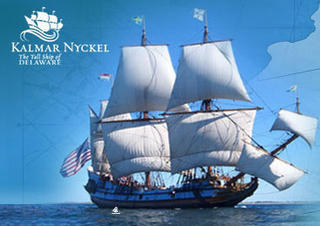
Yesterday, Rosemary and I successfully navigated aboard Cher, world famous 14' yacht, from Pamet Harbor (Truro, Massachusetts) to Provincetown Harbor (and back!). It was only our second attempt, having turned back the previous day before reaching our goal, fearing that we would not make it back in time before dark and extreme low tide. This time however, fully stocked with provisions, cell phones, and cash, we made it to the beach in P-Town and were able to secure one frozen mocha freddo and one frozen chai freddo from the "Wired Puppy", check our email and head home. On our way home we encountered the tall ship Kalmar Nyckel.
Wednesday, August 31, 2005
Montclair: 1; Ramapo: 0
Last night, in a closely-fought game, the Montclair High varsity soccer team defeated perennially powerful Ramapo High varsity soccer team by a score of 1-0. GO BLUE!!!
Sadly, the Montclair freshman squad was defeated by its Ramapo counterpart. But starting (and full-game playing) centerback Graham Christie was singled out after the game by Montclair coach Stu Ball for excellence in his play.
The visitors cheering squad was sparsely attended, due to the traveling distance. But die-hard soccer fan Marge Christie has, once again, stepped out in front of the crowd. You've heard of the Soccer Mom? Well, the original soccer mom is now the Soccer Grandma!
Sadly, the Montclair freshman squad was defeated by its Ramapo counterpart. But starting (and full-game playing) centerback Graham Christie was singled out after the game by Montclair coach Stu Ball for excellence in his play.
The visitors cheering squad was sparsely attended, due to the traveling distance. But die-hard soccer fan Marge Christie has, once again, stepped out in front of the crowd. You've heard of the Soccer Mom? Well, the original soccer mom is now the Soccer Grandma!
Subscribe to:
Posts (Atom)
 Maris Stella Yacht Club and Crabbing Society
Maris Stella Yacht Club and Crabbing Society